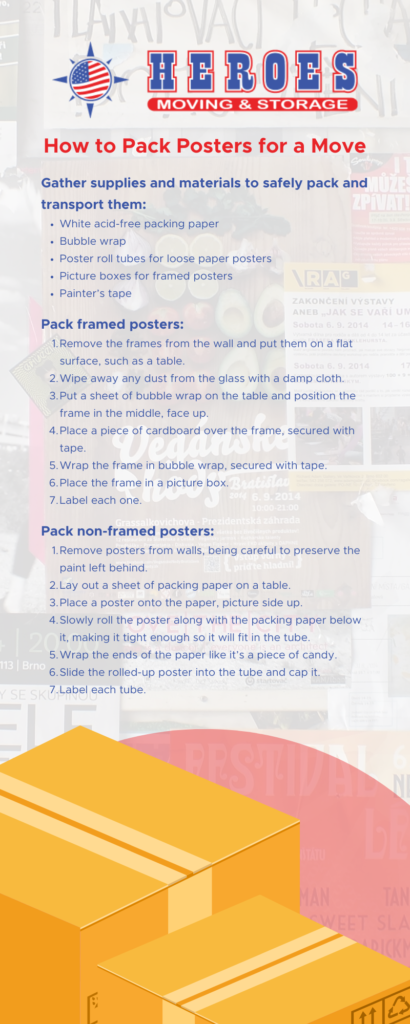How to Pack Posters for a Move

In this guide, our experts at Heroes Moving & Storage delve into the art of packing posters with precision during a move. Recognizing the importance of safeguarding your valued artwork, our Richmond, VA, movers draw on the expertise of a professional mover to provide practical insights on how to pack posters correctly for your upcoming relocation. From understanding poster types to troubleshooting common issues, this step-by-step guide equips you with the knowledge needed for effective and secure poster packing. By the end, you’ll be prepared to handle your poster collection with the care and confidence of a seasoned professional, ensuring a smooth transition to your new space.
Types of Posters Our Richmond Movers Have Encountered
In the process of packing posters for a move, it’s crucial to have a comprehensive understanding of the different types of posters and their respective materials. Movie posters, often printed on glossy paper, require extra care to prevent scratches and preserve the vibrancy of colors. Art prints, with varying materials and sometimes delicate or textured surfaces, demand special attention to ensure their safe transportation. Vintage posters, frequently made from fragile materials, may be more susceptible to tearing, and their value necessitates added protection.
Additionally, it’s essential to identify posters that are fragile or hold significant value, as these require specific handling. Learning how to pack posters you are particularly attached to is important for this. Assessing the condition and age of posters aids in determining their fragility, while conducting a valuation helps prioritize the safety of valuable posters. Noting any existing tears, folds, or damage is crucial to address these issues effectively during the packing process.
Furthermore, accurately assessing the size and quantity of posters plays a pivotal role in planning for their safe packing. Measuring the dimensions of each poster helps determine the appropriate packing materials while counting the total number of posters allows for estimating the amount of packing supplies needed. Considering the diversity in poster sizes and planning accordingly ensures efficient packing arrangements, contributing to a smooth and secure move for these cherished items.
Essential Supplies for Packing Posters
To start on the journey of learning how to pack posters for a move with the precision of a professional mover, assembling the right packing supplies is paramount. A well-equipped arsenal includes packing tubes for posters, packing paper, bubble wrap, packing tape, and cardboard sheets. Each of these supplies serves a specific purpose in safeguarding your posters during transit. Poster tubes are ideal for preserving the integrity of rolled posters, preventing any creases or damage. Packing paper acts as a protective layer, shielding posters from dust and minor abrasions. Bubble wrap, with its cushioning properties, offers an extra layer of defense, especially for delicate or valuable posters. Packing tape secures the ends of poster tubes and ensures the stability of flat-packed posters. Finally, cardboard sheets provide a sturdy foundation, preventing bending or warping during the move. Understanding the significance of each supply ensures a comprehensive and professional approach to poster packing, guaranteeing the safe arrival of your cherished items at their new destination.
- White acid-free packing paper
- Bubble wrap
- Poster roll tubes for loose paper posters
- Picture boxes for framed posters
- Painter’s tape
Finding the Best Way to Pack Posters
Before undertaking the packing process, it’s crucial to give your posters the attention they deserve. Start by gently cleaning and dusting each poster to ensure they are in the best possible condition for the move. This step is particularly important for older or vintage posters that may have accumulated dust over time. Additionally, inspect each poster for any existing damage, tears, or imperfections. Addressing these issues before packing will help prevent further deterioration during transit.
Once your items are in optimal condition for transportation, after you’ve learned how to pack posters for a relocation, the next step is to roll them carefully. Lay each poster flat on a clean surface and, using both hands, roll it from one end to the other. Avoid rolling too tightly to prevent creases. For added protection, consider using rubber bands to secure the rolled posters. This not only helps maintain their rolled shape but also prevents them from unraveling during the move.
Taking the time to prepare your posters before packing sets the stage for a smooth and damage-free relocation. By ensuring they are clean, free from pre-existing damage, and properly rolled, you’re laying the foundation for a secure and well-organized packing process. This thoughtful preparation will contribute to the longevity of your posters and their safe arrival at the new destination.
Packing Framed Posters
- Remove the frames from the wall and put them on a flat surface, such as a table.
- Wipe away any dust from the glass with a damp cloth.
- Put a sheet of bubble wrap on the table and position the frame in the middle, face up.
- Place a piece of cardboard over the frame, secured with tape.
- Wrap the frame in bubble wrap, secured with tape.
- Place the frame in a picture box.
- Label each one.
Packing Unframed Posters
- Remove posters from walls, being careful to preserve the paint left behind.
- Lay out a sheet of packing paper on a table.
- Place a poster onto the paper, picture side up.
- Slowly roll the poster along with the packing paper below it, making it tight enough so it will fit in the tube.
- Wrap the ends of the paper like it’s a piece of candy.
- Slide the rolled-up poster into the tube and cap it.
- Label each tube.
How to Transport Posters With Different Methods
With your posters prepped and ready, it’s time to dive into the practical aspects of packing. If you’ve opted for the convenience of poster tubes, follow these guidelines for a secure packing experience. Roll each poster carefully, using both hands to maintain an even and gentle pressure. Insert the rolled posters into the tubes, securing the ends to prevent any accidental unraveling during transit.
For larger posters that are better suited to a flat packing method, layering is key. Place a protective material, such as cardboard or bubble wrap, on a flat surface. Position the posters on top, ensuring even weight distribution. Add additional protective layers between posters to prevent any potential damage. Once arranged, secure the entire package with strong packing tape, creating a stable and well-protected bundle.
When dealing with multiple posters of similar characteristics, consider packing them together. Bundle posters that share size or fragility traits and ensure even weight distribution for a balanced package. Utilize dividers or additional protective layers between posters to prevent any friction or potential damage during the move.
Combining these methods of how to pack posters provides a versatile approach to packing posters. Whether you choose the convenience of poster tubes, the stability of flat packing, or the efficiency of bundling similar posters together, these techniques cater to the diverse needs of your poster collection. Each method is designed to maximize protection and minimize the risk of damage, ensuring your posters reach their new destination in pristine condition. Once you’re settled, it is important to investigate how to put up a poster without damaging it.
Common Issues to Keep an Eye Out for
While learning how to pack posters with care is the goal, unforeseen challenges may arise during the move. Addressing common issues proactively will help ensure the safe transportation of your cherished posters.
Addressing potential challenges like wrinkling or tearing: Despite your best efforts, posters may still face the risk of wrinkling or tearing during the move. To mitigate this, inspect posters for any signs of damage upon arrival. For minor wrinkles, carefully unroll the poster and place it between two clean surfaces, applying gentle pressure to restore its flatness. Torn posters may require delicate repair using acid-free tape.
Providing solutions for unexpected problems during the move: Should unexpected issues arise, such as boxes shifting during transit, conduct a thorough inspection upon reaching your destination. If posters have shifted or sustained damage, assess the extent of the issue and address it promptly. Reposition posters within their packaging, and reinforce damaged areas with additional protective layers if necessary.
Emphasizing the importance of flexibility and adaptability: Flexibility is key when encountering unexpected challenges. Stay adaptable and open to making on-the-spot adjustments to your packing strategy. Having extra packing materials on hand allows you to reinforce or modify your poster protection methods as needed. Remember, being flexible in your approach ensures that your posters remain a priority, even in the face of unexpected circumstances.
By troubleshooting common issues with a proactive mindset, you can navigate the complexities of a move and safeguard your posters effectively. The ability to address challenges as they arise ensures that your posters arrive at their new home in the best possible condition, maintaining their value and sentimental significance.
Get in Touch With Our Richmond Moving Company
Searching for experts who not only know how to pack posters but also know how to make your relocation go smoothly? Look no further. Whether you’re moving residences or offices, the insights in our moving blog will equip you for a smooth and secure transition by providing important information such as how to pack frames for moving. Get ready to make your next relocation a breeze with our team of professionals, get in touch today to schedule your next move or just to learn more about how our experts can help.
FAQs About How to Pack Posters
How Do You Transport a Flat Poster?
To transport a flat poster, we recommend using a sturdy poster tube or placing it between two rigid surfaces, such as cardboard sheets. Secure the package with packing tape to prevent bending or creasing during transit.
How Do You Travel With PosterS?
When traveling with posters, it’s best to roll them and place them inside a durable poster tube. This protects them from damage and ensures they stay in pristine condition throughout your journey. Avoid folding posters, as this can lead to permanent creases.
How Do I Protect My Posters When Traveling?
To protect your posters when traveling, use poster tubes for rolled posters. If carrying flat posters, place them between protective layers, like cardboard or bubble wrap, and secure the bundle with packing tape. Keep the posters in a secure and climate-controlled space to prevent damage from extreme temperatures or humidity.
How Do You Pack Multiple Posters?
Packing multiple posters is efficient when bundled based on size or fragility. Place similar posters together and use dividers or protective layers between them. Ensure even weight distribution in the package to prevent shifting during transit. Use a combination of poster tubes and flat-packing methods for diverse poster sizes.
How Do I Organize My Posters?
Organizing posters is essential for a smooth move. Categorize them by size, type, or fragility. Create an inventory list and label each package accordingly. This helps in efficient packing, unpacking, and locating specific posters at your new location. Utilize dividers or separate containers for different categories to maintain order.


